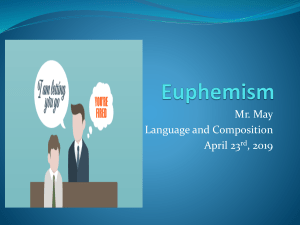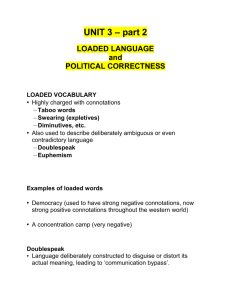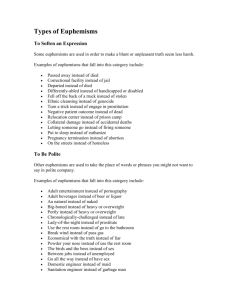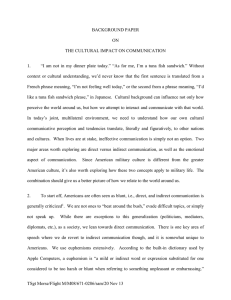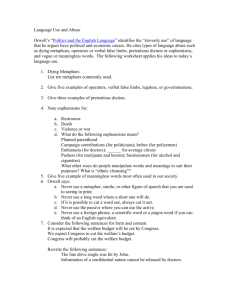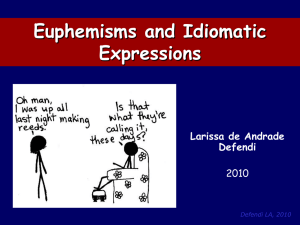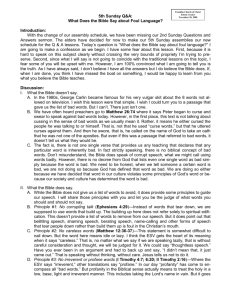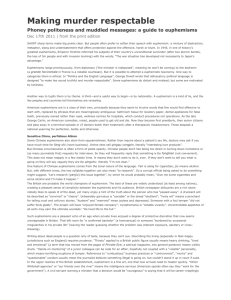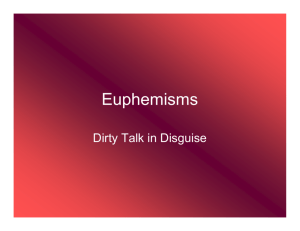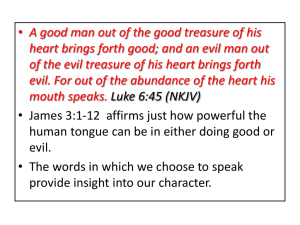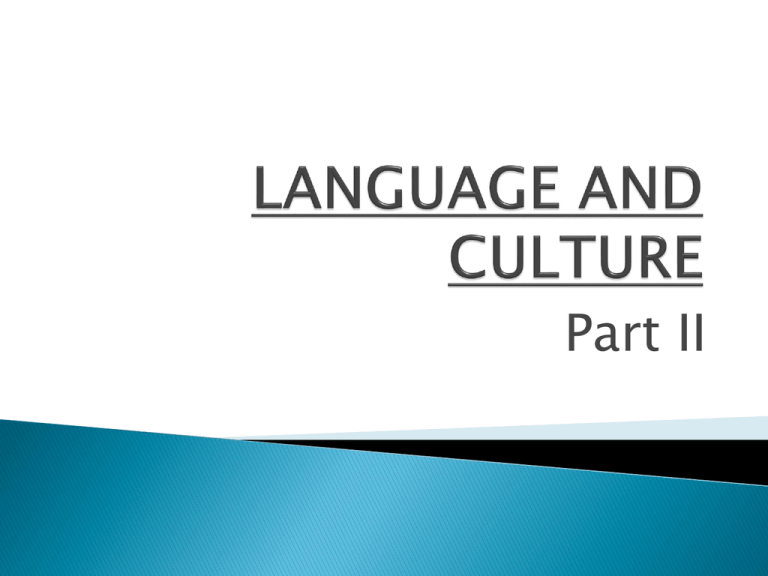
Part II
Language: has its own classes of units
(vowels and consonants; nouns and verbs;
statements and questions)
used to classify and categorize various
aspects of the world
People do not always classify things the way
scientists do
folk taxonomies # scientific classifications
folk
etymology- way of
classifying a certain part of
reality so that it makes some
kind of sense to those who have
to deal with it.
Typically, taxonomies of the
flora and fauna
Frake’s study of folk taxonomy: account of the terms that
the Subanun (southern Philippines) use to describe
disease
considerable amount of disease among the Subanun,
discussed at length (d. of the skin).
a variety of categories when discussing a particular set of
symptoms
nuka can refer to skin disease in general but also to
‘eruption’.
further distinguished as a beldut ‘sore’ rather than a
meŋabag ‘inflammation’, or buni ‘ringworm’, and then the
particular beldut can be further distinguished as a
telemaw ‘distal ulcer’ or even a telemaw glai ‘shallow
distal ulcer’
a hierarchy of terms with a term like nuka at the top and
telemaw glai at the bottom.
Also used to explore relationship between
different languages and cultures. The color
spectrum- physical continuum that doesn't
show any breaks. Still, humans divide it into
bits and assign names to the component
parts: green, blue, yellow, red.
Are color terms arbitrary, or is there a
general pattern? If there is a pattern, what
are its characteristics?
All languages make use of basic color terms.
A basic color term must be a single word
(blue or yellow) and not some combination
of words (light blue or pale yellow). It
mustn't be a sub-division of some higherorder term (crimson (dark red); scarlet
(bright red)- higher-order term is red). A
basic color must also have a general use- it
mustn't be applied to a narrow range of
objects (blond- only for color of hair and
wood).
L. with 2 color terms- equivalent in English black
and white. 3rd is red. The 4th and the 5th- yellow
and green. The 6th and the 7th are blue and
brown. And then: gray, pink, orange and purple
relationship between the extent of color
terminology in a l. and the level of technical
complexity of that society: not technologically
advanced communities- fewest color terms, e.g.
the JALÉ of New Guinea: words corresponding only
to black (dark) and white (light). Technologically
advanced societies have terms corresponding to all
eleven mentioned above. Societies in intermediate
stages have intermediate numbers, e.g. the TIV of
Nigeria (3 terms), the GARO of Assam and the
HANUNÓO of the Philippines have 4, while the
BURMESE have 7
BLACK- seen in its cold and negative aspect: black comedy,
WHITE- associated with purity, innocence, chastity,
recognition, cowardice, defeat: white Christmas, white
black economy, black eye, black look, black magic, black
sheep (of the family), black mood, the pot calls the kettle
black (rugala se sova sjenici).
elephant (expensive, but not useful), white lie, white hair (old
person, also euphemistic), white handed (honest man), white
horses (waves white at the top), white magic (used to do
good), white wedding (traditional Christian marriage in a
church at which the woman wears a white dress).
RED- symbolically related to fire, blood, love, spirit, beauty,
strength, health, energy, joy, sex, success, anger, courage,
and patriotism: red-letter day (special, important), red tape,
red-blooded (energetic, sex-loving), red-hot (successful),
red-light district, in the red, paint the town red, see red.
Rosch: concepts are best viewed as
prototypes: a ‘bird’ is not best defined by
reference to a set of features that refer to
such matters as wings, warm-bloodedness,
and egg-laying characteristics, but rather
by reference to typical instances, so that a
‘prototypical bird’ is something more like a
robin than it is like a penguin, ostrich, or
even eagle. This is the theory of prototypes.
People classify objects according to what
they regard as being typical instances (a
chair is a typical item of furniture, an
ashtray is not; apples and plums are
typical fruit, coconuts and olives are not)
Hudson: prototype theory has much to
offer sociolinguistics
Language- used to express things, but avoid
saying certain things as well.
Certain things are not said, because people
refuse to talk about those things→taboo
if those things are talked about, they are
talked about in very roundabout
ways→euphemism
refers to things that are simply not talked
about- one way in which a society
expresses its disapproval of certain kinds of
behavior believed to be harmful to its
members, either for supernatural reasons,
or because such behavior is thought to
violate a moral code
Tabooed subjects: sex, death, excretion,
bodily functions, religious matters and
politics
In some cultures they even include names
of animals
when someone breaks the rules, it might cause
problems, although maybe not as much today
as in the past (Shaw's use of bloody in
Pygmalion, or damn in "Gone With the Wind"
Taboos- violated to claim free speech, draw
attention to yourself,
Freud: breaking a taboo (a sex one) is a form of
verbal seduction-"talking dirty".
The penalty for breaking a linguistic taboo can
be severe- blasphemy and obscenity are still
crimes in many jurisdictions (but hardly likely to
cost you your life)
violation of certain non-linguistic taboos (e.g.
incest ones) might have severe consequences in
certain places in the world.
Haas: certain l. taboos arise from bilingual
situations: the Creeks of Oklahoma- as they use
more English, they avoid Creek words
resembling English taboo words: fakki (soil),
apiswa (meat), apissi (fat).
Similarly: Thai students learning English avoid
using words like fag (sheath) in the presence of
Anglophones; also avoid using yet and keysound like the Thai words jed (to have
intercourse) and khîi (excrement). Even personal
names might cause embarrassment in a
different l. environment: the Vietnamese name
Phuc in an anglophone group
Euphemism (Gr. eu=well, pheme=speak)- a
metaphorical or metonymic use of an expression in
place of another expression that is offensive.
Eupheme- originally a word or a phrase used in
place of a religious word or phrase that should not
be spoken aloud (unspeakable names for a deity,
such as Nemesis or Yahweh). By using
euphemisms, the speaker was believed to please
gods and stay in their good fortune.
e.g. medvjed- the term avoids the association with
a beast by describing it as a "honey eater”.
used to deliberately cloud an issue or to misdirect
attention
used to "dress up" certain areas of life and neutralize
the unpleasantness (sex, bodily functions, dying,
unemployment, criminality and many others)
allow us to give labels to unpleasant tasks and jobs
in an attempt to make them sound almost attractive
number of areas in which we can find e. is increasing
all the time (being fat, getting old-especially in the
States).
Nadel: the Nupe of West Africa- the most prudish people
in the world (sharp distinctions between expressions that
are suitable for polite conversation and that are not)
constantly resort to circumlocutions and euphemisms to
avoid direct mention of sex, body parts or bodily
functions. They have developed indirect ways of referring
to tabooed matters (rich system of metaphors).
the Nupe have developed indirect ways of referring to
tabooed matters, ways they can employ on these
occasions when it is possible to free themselves from
normal constraints, e.g. in certain kinds of story-telling or
on specific festive occasions.
terms of foreign origin (copulation, perspire,
urinate)
abbreviations (SOB-son of a bitch, BS-bullshit, TStough shit)
abstractions (it, the situation)
indirections (sleep together, privates, go to the
bathroom)
mispronunciations (goldarnit-God damn it,
freakin'-fucking)
plays on abbreviations (barbecue sauce-BS, sugar
honey ice tea-SHIT, Maryland Farmer-MF)
The English l. has many e. related to death, dying,
burial and the people and places which deal with
death. This is connected with the magical belief
that to speak the word 'death' meant inviting death.
Some colloquial euphemisms:
pass away, pass on, meet the maker, go to sleep,
go to the other side, go to rest, go to the final
reward, go West, croak, kick the bucket, bite the
dust; of pets: put away, put to sleep; gangsters'
jargon: deep six (six feet under), rub out, erase,
waste, make sb. sleep with the fish
intellectually challenged, slow- stupid
differently-abled- handicapped
needy, under-privileged, disadvantagedpoor people
underdeveloped, developing, emergent, Third
World- poor countries
darn-damn
heck-hell
life insurance-death insurance
dentures-false teeth
ethnic cleansing-genocide
collateral damage-killing of innocents
perspire-sweat
bathroom-toilet
social disease-venereal disease
A1- amphetamine ingested illegally
AC/DC- behaving both heterosexually and homosexually
B- bloody, as in B fool; bitch, as in silly B
BO- body odor
C- cancer, as in the big C; cocaine; crack
D- damn, damned, damnable; big D is death
DCM- notice of dismissal from employment (Don't come Monday)
G- gee, jeez, Jesus; G-man- federal agent working for the
U.S.Government
H- hell (what the H?); heroine
M- marijuana
N- nigger, (the N-word)
O- not oxygen, but opium
P- piss, p off
What distinguishes doublespeak from other
euphemisms is its deliberate usage by
governmental and military institutions.
Commentators such as Noam Chomsky and George
Orwell have written a lot about the dangers of
allowing such euphemisms to shape public
perceptions and national policy.
Examples of doublespeak:casualties for deaths;
taking friendly fire for being attacked by your own
troops; "the Final Solution" for Nazi's plan to
murder the world's Jews.
the Croats laugh and scorn euphemisms
more than the Americans do- there are
fewer ethnic and social group in Croatia and
it isn't absolutely necessary to be politically
correct.
some of the new euphemisms (particularly
those invented in the USA) are silly and
unnecessary: vertically challenged- short
person; carnal knowledge- sexual
intercourse; service the target- kill the
enemy; immortally challenged- dead.
Euphemisms can influence memory as well as
perception
after seeing a film of a multiple-car accident, 50
subjects were asked: How fast were the cars
going when they hit?, and 50 were asked: How
fast were the cars going when they smashed?
The hit subjects averaged 8 miles/h, and the
smash subjects 11 miles/h. Both groups were
also asked: Did you see any broken glass?
(There was none in the film.) Of the hit subjects,
7 said yes, and of the smash subjects 16.

